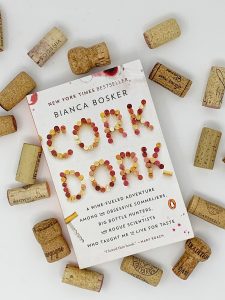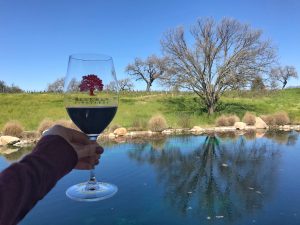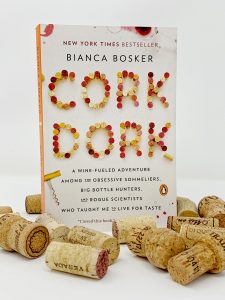I recently had a day off of work, and as fate would have it our power was shut off that day, too. That meant no Netflix, internet (on my laptop), or any other techie ways to pass my time. I decided to finally open up a book that was given to me at Christmas called Cork Dork. I had been saving it for a time when I knew I could really dig in and enjoy it. This was that time!

I expected to find the book interesting, but I never expected to get sucked into it the way that I did. I read almost the entire thing within a day. It’s been years since I last did that with a book! Bianca Bosker, author of Cork Dork, takes her reader on a journey through her introduction into the world of wine. Her lighthearted writing style and philosophical approach to her journey is refreshing, inspiring, and exhilarating.
Here’s the general premise (no spoilers):
Bianca, a tech writer, finds out about the elusive world of wine by stumbling upon videos of Sommeliers blind tasting. Bianca’s knowledge of wine at this point is introductory at best…she mostly knows it as a means of getting drunk. How could it be that these savants on YouTube are taking a sip of red grape juice and identifying not only what grape it was made from, but also the exact location in the WORLD) that the grape was grown in, and sometimes the exact bottle and vintage of the wine? Bianca sets out on a personal quest to determine whether this Sommelier world is just a façade to a “bullshit-prone” industry (her term, not mine), or whether there is any trainable skill that can allow for this type of sensory detection.
Bianca gives herself one year to learn about wine and pass the Certified Sommelier Exam.
She throws herself at it full-force, documenting her experiences along the way. There are some definite characters in the book, but even more impressive is how much scientific research Bianca poached herself in in order to truly demystify this elusive wine world. From Harvard research studies, to Napa Valley flavor scientists, this autobiography-of-sorts gives a peek into all facets of wine in a humorous, entertaining, and easy-to-understand way.
While I had heard bits and pieces of what’s wrong with many of the affordable wines that are mass distributed throughout the US, Bianca’s book opened my eyes to information that (I assume) few are aware of. Think: additives, fillers, food colorings, etc. in the perceivably “pure” wine you’re purchasing for $12 at your local grocery store. Here’s a brief excerpt of what Bianca discovered in her journey to write Cork Dork (note: the following information will probably be disturbing if you’re a cheap-wine lover…proceed with caution):
“There is no fault [in wine] that can’t be corrected with one powder or another; no feature that can’t be engineered from a bottle, box, or bag. Wine too tannic? Fine it with Ovo-Pure (powdered egg whites), isinglass (granulate from fish bladders), gelatin (often derived from cow bones and pig skins), or if it’s a white, strip out pesky proteins that cause haziness with Puri-Bent (bentonite clay, the ingredient in kitty litter). Not tannic enough? Replace $1,000 barrels with a bag of oak chips (small wood huggets for flavor), “tank plants” (long oak staves), oak dust (what it sounds like), or a few drops of liquid oak tannin (pick between “mocha” and “vanilla”). Or simulate the texture of barrel-aged wines with powdered tannin, then double what you charge. (‘Typically, the $8 to $12 bottle can be brought up to $15 to $20 per bottle because it gives you more of a barrel quality…You’re dressing it up’ a sales rep explained).” (Bosker, 2017, p. 188)
That’s not all. Ingredients found in watercolor paints, anti-foaming agents, salt, chalk, cream of tartar, sugar, water, designer yeasts (to mimic “honey”, “cherry cola”, or “fresh butter”, for example), Velcorin (an ingredient that kills microbes that is known to be toxic…so only use it in small amounts), and MegaPurple grape juice concentrate (don’t kid yourself, an estimated 25 million bottles in the $20 or less range contain this magical concentrate each year) are just a few more of the commonly found ingredients in affordable wine. (Bosker, 2017)
More than 60 additives can legally be added to wine. Think about that…if you’re buying big-brand affordable wines, chances are you’re ingesting just a few of them.
To take it to a broader level, this is one of the reasons I feel it is important to support small, independent wine producers. They typically are not producing mass quantities of bottles, which allows them to control the flavor of their wines in natural ways (with naturally-occurring yeasts, barrels, and, you know, that thing called nature). Yes, more than likely you will be paying more for a bottle of wine at a place like this, but that’s for good reason. You’re paying for quality, and while there may be a few additives, they will be nowhere near the MegaPurple or Puri-Bent found in your $8 grocery store bottle.
I’ve been passionate about finding certified organic and biodynamic wines for a while now, and a big part of my drive for this is to ensure that there are fewer chemicals used in the grape-growing and wine-making process. There are a couple major certifications for bioidynamic wine, Wine Folly writes all about them. Looking for these indicators is another way to make an educated choice about the wine you’re consuming. A couple of my favorite biodynamic wineries are Troon Vineyard in Southern Oregon, and Beckmen Vineyards in Los Olivos, California. I’m excited to find more biodynamic wineries on my trip to Willamette Valley wine country in Oregon next week!

Whether you’re a die-hard wino or a skeptic of all the “notes” of peaches, tobacco, and wet soil that are supposedly sniffed in a glass of wine, Cork Dork is a book for you. I feel I’m a more educated wine drinker and purchaser after reading Bianca’s story. I also sort of wish I had thought of her idea to document a year-long, fully-immersive journey in the wine world first…ha!
Here’s a link to purchase Cork Dork if you’re interested: https://amzn.to/2DVduYT

Cheers!
